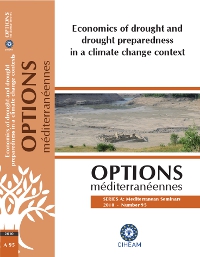| p. 9-18 | Article suivant |
Climate change and its impact on agricultural production, with a focus on the Mediterranean area
Climate change will impact and has already impacted a large range of physical/biological systems and sectors of the human activity, among them agriculture (including livestock) and its main output as food production. A large number of existing works allows to identify a reliable perspective on the predicted consequences for the various productions and the various regions, which may significantly differ from one to the another: they result from the combination of a large set of elementary components of the plant ecophysiology, including the stimulation of photosynthesis by the carbon dioxide. These diverse effects may vary from positive (by some 20 percent) in some temperate conditions to highly negative (down to 50 percent reductions) in warm conditions. This range may be encountered within the Mediterranean basin, but there is a general tendency to a worsening of climatic conditions, by the combination of warmer and drier conditions. More than in other geographic areas, water availability will be the major limiting factor. The agricultural sector will have to face this worsened future and to adopt a range of adaptive measures. The observed recent evolution, which appears similar to the long-term projections, gives a first perception of the necessary changes, but the near future is still rather uncertain about the velocity of climate change in the mid-term horizon (2030, for instance).
Le changement climatique va impacter, et a déjà notablement impacté, un large éventail de systèmes physiques/biologiques et de secteurs de l'activité humaine, parmi lesquels l'agriculture (incluant l'élevage) et sa principale fonction de production de l'alimentation. Un assez grand nombre de travaux existent qui permettent d'avoir une perspective fiable sur les conséquences prévisibles pour les différentes productions et dans les différentes régions, qui peuvent varier significativement de l'une à l'autre. Elles résultent en effet de la combinaison d'un large jeu d'actions élémentaires sur l'écophysiologie des plantes, intégrant l'effet de stimulation de la photosynthèse par le dioxyde de carbone. Ces effets divers, qui peuvent aller de légèrement positifs (jusqu'à 20 pour cent) dans des conditions tempérées à fortement négatifs (jusqu'à 50 pour cent de réduction) dans des climats chauds peuvent être rencontrés dans les différentes parties du bassin méditerranéen. Mais la tendance générale est très probablement celle d'une détérioration des conditions climatiques, par la combinaison de conditions plus chaudes et plus sèches. Plus que dans d'autres aires géographiques, c'est la disponibilité de l'eau qui va devenir le facteur limitant. Le secteur agricole va devoir s'adapter à ces nouvelles conditions, globalement plus défavorables. L'évolution climatique récente, observée, assez semblable aux tendances projetées, donne un avant-goût des changements nécessaires, mais il subsiste une interrogation sur la vitesse d'évolution à moyen terme (horizon 2030, par exemple).
- [ Afficher ]
- [ Télécharger ]
- [ Exporter la citation ]
Vous pouvez télécharger la citation au format :
- [ Imprimer ]
-
Mots-clés
AGRICULTURE, CHANGEMENT CLIMATIQUE, EVALUATION DE L'IMPACT, PRODUCTION ALIMENTAIRE, PRODUCTION VEGETALE, REGION MEDITERRANEENNE, SECHERESSECiter cet article
Seguin B. Climate change and its impact on agricultural production, with a focus on the Mediterranean area. In : López-Francos A. (comp.), López-Francos A. (collab.). Economics of drought and drought preparedness in a climate change context. Zaragoza : CIHEAM / FAO / ICARDA / GDAR / CEIGRAM / MARM, 2010. p. 9-18. (Options Méditerranéennes : Série A. Séminaires Méditerranéens; n. 95). 2. International Conference on Drought Management, 2010/03/04-06, Istanbul (Turkey). http://om.ciheam.org/om/pdf/a95/00801319.pdf



